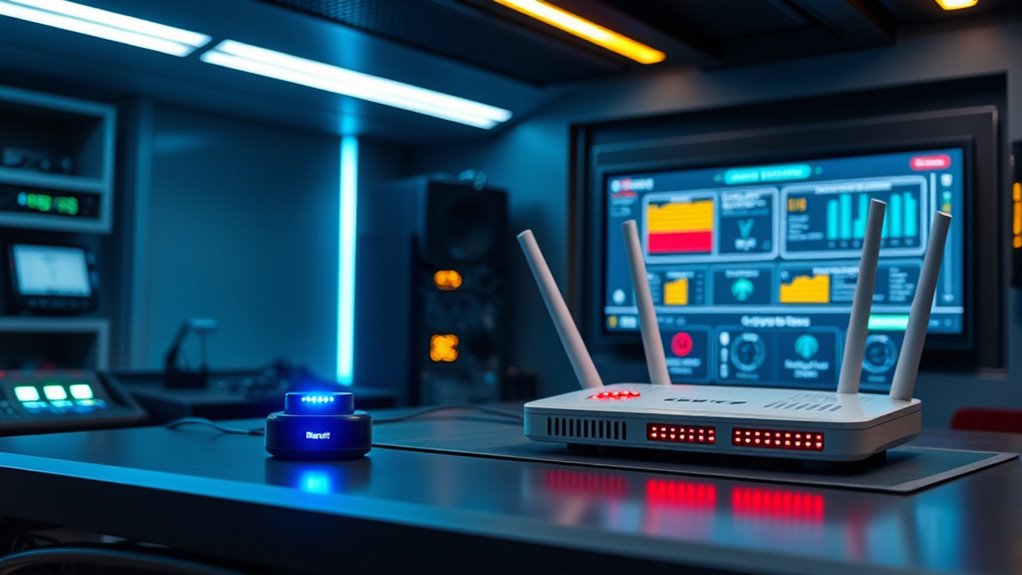Bluetooth offers quick, low-latency communication over short distances, making it ideal for close-proximity alerts, but its limited range can affect reliability in larger areas. Wi-Fi provides broader coverage and adaptable bandwidth, guaranteeing more stable signals over longer distances, but it consumes more power and can face interference. To guarantee the most reliable alerts, understanding these differences helps you choose the best fit—more details follow.
Key Takeaways
- Bluetooth offers low latency with priority pairing but limited range, ideal for close-proximity real-time alerts.
- Wi-Fi provides broader coverage and adaptive bandwidth, maintaining high-speed communication in larger environments.
- Bluetooth’s interference resistance via frequency hopping enhances stability in busy settings, though its short range limits deployment.
- Wi-Fi’s stronger signal stability and interference management suit large-scale, high-demand alert systems.
- Both technologies require proper security protocols; Bluetooth uses AES-CCM, while Wi-Fi relies on WPA3 for data protection.
Latency Performance in Real-Time Communication

When evaluating real-time communication, latency performance is a crucial factor because it directly impacts how quickly alerts are transmitted and received. Bluetooth and Wi-Fi handle latency differently, affecting their suitability for urgent alerts. Bluetooth often uses priority pairing, ensuring essential alerts get precedence, which reduces delays in transmission. Wi-Fi, on the other hand, benefits from adaptive bandwidth, dynamically adjusting data flow to minimize latency during high-traffic periods. This flexibility helps maintain faster alert delivery, especially in complex environments. Both technologies aim to optimize latency, but Wi-Fi’s ability to adapt bandwidth provides an advantage in maintaining low latency levels during peak usage. Additionally, tuning of network settings can further enhance communication speed and reliability. Understanding these mechanisms helps you choose the best option based on how swiftly alerts need to reach your devices.
Range Capabilities and Coverage Areas

Bluetooth generally offers a shorter range, typically up to 10 meters (33 feet), making it ideal for close-proximity connections like wearable devices or personal gadgets. Its limited coverage means device pairing is quick and reliable within this area, guaranteeing stable communication. However, this range restricts its use in larger spaces or distributed environments. Regulatory compliance plays a role in setting power limits, which directly impact Bluetooth’s coverage. Wi-Fi, on the other hand, provides considerably broader coverage, often spanning hundreds of meters indoors and even kilometers outdoors, depending on the network setup. This extensive range allows for flexible device deployment across large areas. When selecting between Bluetooth and Wi-Fi, consider your coverage needs, device pairing requirements, and regulatory constraints to ensure dependable communication in your environment. Coverage limitations are a key factor influencing the choice between these wireless technologies.
Interference Resistance and Signal Stability

Interference can disrupt your device’s signal and affect alert reliability, so understanding susceptibility is vital. Factors like overlapping frequencies and environmental obstacles play a big role in connection stability. Knowing how Bluetooth and Wi-Fi handle these issues helps you choose the best option for consistent alerts. Additionally, environmental factors such as physical barriers and electromagnetic interference can further impact signal stability, emphasizing the importance of selecting a technology with greater interference resistance.
Signal Interference Susceptibility
Although both Bluetooth and Wi-Fi operate within crowded radio frequency bands, their resistance to interference varies markedly. Bluetooth uses frequency hopping spread spectrum, rapidly switching channels to avoid interference and maintain a stable connection. This makes it more resistant to localized disruptions, especially in environments with multiple devices. Device pairing in Bluetooth also helps reduce interference issues, as it creates a dedicated link that minimizes cross-talk from other signals. Wi-Fi, on the other hand, typically stays on a fixed channel, making it more vulnerable to interference from other Wi-Fi networks or electronic devices operating nearby. While Wi-Fi can adapt by changing channels manually or automatically, it’s generally more susceptible to signal disruptions in highly congested areas. Additionally, the design of Bluetooth’s protocol prioritizes interference resistance, enhancing connection stability in busy environments.
Connection Stability Factors
When it comes to connection stability, resistance to interference and signal consistency are crucial factors that can make or break real-time alert systems. Bluetooth generally offers good stability with low hardware requirements and broad device compatibility, but it can be affected by interference from other Bluetooth devices or Wi-Fi networks. Wi-Fi, on the other hand, provides stronger signal stability and better resistance to interference in environments with multiple devices, thanks to its higher bandwidth and advanced channels. However, it demands more robust hardware and may require more configuration for ideal performance. Your choice depends on your device compatibility needs and the environment’s interference levels. Ensuring stable connections involves understanding these factors and selecting the technology that best fits your hardware setup and operational conditions. Considering the specific performance features of each technology can help optimize reliability in various scenarios.
Power Consumption and Energy Efficiency

Power consumption is a critical factor when choosing between Bluetooth and Wi-Fi for real-time alerts, as it directly impacts device battery life and operational efficiency. Bluetooth generally consumes less power, making it ideal for devices with limited battery capacity. Its low energy mode allows for extended battery life through effective power management, especially during infrequent data transfers. Wi-Fi, on the other hand, tends to use more energy due to its higher data throughput and continuous connectivity requirements. While this can drain batteries faster, Wi-Fi’s energy efficiency improves with optimized protocols and smart power management strategies. Ultimately, your choice depends on balancing the need for prolonged battery life with the frequency and volume of data transmitted, ensuring reliable alerts without compromising device longevity. Additionally, understanding energy efficiency strategies can help optimize both technologies for better long-term performance.
Scalability and Network Expansion

As your network grows, the scalability of Bluetooth and Wi-Fi systems becomes a key consideration for maintaining reliable real-time alerts. Bluetooth, especially when using mesh networks, can easily expand by adding more devices that forward data, improving coverage without overloading individual nodes. However, device compatibility can sometimes limit expansion if newer devices don’t support the same Bluetooth versions or mesh features. Wi-Fi, on the other hand, offers robust scalability through existing infrastructure, allowing you to add access points and routers to increase capacity. It generally supports a wide range of devices, making expansion straightforward. Still, managing larger Wi-Fi networks requires careful planning to prevent interference and ensure consistent performance. Both systems can scale effectively, but your choice depends on your specific network needs and device compatibility. scalability is a crucial factor to consider when planning your network expansion to ensure reliable real-time alerts.
Security Features and Data Protection

When comparing Bluetooth and Wi-Fi, security features like encryption standards play a vital role in protecting your data. You should consider how vulnerable each technology is to interception and whether their device authentication protocols are strong enough. These factors directly impact the reliability of your real-time alerts and overall data safety. Additionally, understanding the specific cultural and regional breakfast traditions associated with each technology can help tailor security measures to different user preferences and regional regulations.
Encryption Standards Comparison
Encryption standards play a essential role in ensuring the security and integrity of real-time alerts transmitted via Bluetooth and Wi-Fi. You need to understand how encryption protocols protect your data privacy during transmission. Bluetooth primarily uses AES-CCM encryption, which provides strong security for low-power devices, but its protocols can vary across versions. Wi-Fi typically relies on WPA3, offering advanced encryption and improved protection against attacks, making it more robust for sensitive data. Both technologies aim to safeguard your information, but Wi-Fi’s encryption standards generally provide a higher level of security. When choosing between them, consider the strength of their encryption protocols and their ability to maintain data privacy, especially for critical real-time alerts. This comparison helps you assess which technology better secures your communications. Additionally, knowledge of industry trends and online platforms can help you stay updated on the latest security features and best practices.
Vulnerability to Interception
Both Bluetooth and Wi-Fi employ security features designed to protect data from interception, but their effectiveness varies based on their mechanisms. Encryption vulnerabilities pose ongoing risks, especially if weak protocols are used. Bluetooth’s short-range design limits interception risks but isn’t immune—attackers can exploit encryption flaws. Wi-Fi, covering larger areas, faces higher interception threats if encryption isn’t robust. Here’s a quick comparison:
| Feature | Bluetooth | Wi-Fi | Notes |
|---|---|---|---|
| Encryption Vulnerabilities | Sometimes vulnerable to attacks | Often targeted due to wider use | Stronger protocols reduce risks |
| Interception Risks | Lower due to range limitations | Higher over extended coverage | Proper encryption essential |
| Data Protection Measures | AES encryption (standard) | WPA2/WPA3 encryption | Up-to-date protocols improve security |
| Attack Susceptibility | Vulnerable if outdated protocols | Vulnerable if misconfigured | Regular updates needed |
Additionally, ongoing advancements in security protocols help mitigate some of these vulnerabilities.
Device Authentication Protocols
Device authentication protocols serve as the first line of defense against unauthorized access, ensuring that only legitimate devices connect to networks or paired peripherals. During device pairing, these protocols verify identities to prevent imposters from gaining entry. Bluetooth often uses simple pairing methods, which can sometimes be less complex but more vulnerable, while Wi-Fi employs more robust, multi-step authentication processes. The protocol complexity directly impacts security; simpler protocols may speed up connections but risk weaker protection. You need to guarantee these factors when choosing a technology for real-time alerts. Strong device authentication ensures data stays protected and reduces the chance of malicious interference. Ultimately, understanding the balance between ease of device pairing and protocol complexity helps you enhance your network’s security and reliability.
Use Case Suitability and Deployment Considerations

When choosing between Bluetooth and Wi-Fi for real-time alerts, understanding their suitability for specific use cases and deployment environments is essential. You’ll need to reflect on factors like device compatibility, network range, and infrastructure costs. Bluetooth excels in short-range, low-power scenarios, making it ideal for wearable health devices or asset tracking within a confined space. Wi-Fi, on the other hand, supports broader coverage, higher data rates, and can connect multiple devices simultaneously, suitable for large facilities or environments requiring high bandwidth. Deployment considerations include:
- Ease of integration with existing systems
- Infrastructure costs and maintenance
- Compatibility with your device ecosystem
Balancing these factors helps ensure reliable alerts tailored to your operational needs.
Frequently Asked Questions
How Do Bluetooth and Wi-Fi Compare in Terms of Cost?
When comparing Bluetooth and Wi‑Fi, consider their cost efficiency and affordability factors. Bluetooth typically offers lower initial costs and is more affordable for short-range, device-to-device communication. Wi‑Fi might have higher setup expenses but is more suitable for extensive networks. Your choice depends on your budget and coverage needs. If you prioritize cost savings, Bluetooth is usually more budget-friendly, but for broader, more reliable connectivity, Wi‑Fi’s investment may be justified.
Which Technology Is More Environmentally Friendly?
Imagine saving the planet one signal at a time—sounds heroic, right? You’d think Bluetooth’s tiny energy consumption makes it the eco-warrior here, with a minimal ecological footprint. Wi-Fi, on the other hand, guzzles power like an overenthusiastic vacuum, increasing energy consumption and environmental impact. So, if you’re serious about being green, Bluetooth’s your best bet for reducing energy consumption and keeping your ecological footprint small.
How Do User Devices Impact Connection Reliability?
Your user devices play a vital role in connection reliability. Device interference from other electronics or crowded networks can disrupt signals, leading to unstable connections. This interference affects connection stability, making real-time alerts less dependable. To improve this, guarantee your devices are updated, minimize interference sources, and select the best settings. By managing these factors, you can enhance overall connection stability and guarantee your alerts come through consistently.
What Are the Maintenance Requirements for Each System?
Maintaining your systems is like tending a garden—you need regular care. For Bluetooth, you should check battery lifespan and replace batteries before they die. Wi-Fi requires updates to firmware and monitoring for signal interference, which can disrupt alerts. Both systems benefit from cleaning and ensuring secure connections. Regular maintenance keeps your alerts reliable, reducing downtime and ensuring your devices perform at their best.
How Do Updates and Firmware Upgrades Differ Between Bluetooth and Wi-Fi?
When it comes to updates and firmware upgrades, Wi-Fi devices typically receive faster, more seamless updates through internet connections, minimizing downtime and preserving battery lifespan. Bluetooth devices often require manual updates via pairing with a host device, which can be less efficient. Security concerns differ too; Wi-Fi updates tend to have more robust security protocols, while Bluetooth updates may pose higher security risks if not properly managed.
Conclusion
Choosing between Bluetooth and Wi-Fi for real-time alerts isn’t just about technology—it’s about trusting what keeps your connections alive when it matters most. Imagine a system that’s reliable, secure, and ready to adapt, giving you peace of mind in critical moments. Whether it’s the close-range reassurance of Bluetooth or the expansive coverage of Wi-Fi, your decision shapes how confidently you respond. In the end, it’s about feeling connected when it counts the most.











